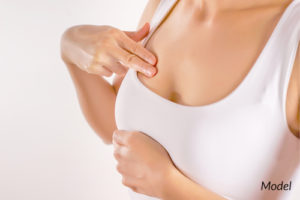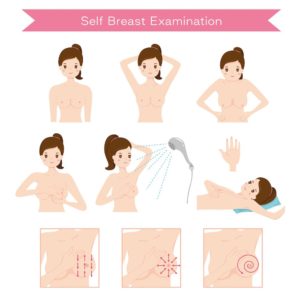What Is the Right Way to Perform a Breast Self Exam?
Posted February 28, 2020 in Breast Health
It is a regrettable fact that breast cancer will affect the lives of one out of every eight women.
While you cannot prevent breast cancer, you can improve your doctor’s ability to treat this cancer with early diagnosis.

What Are Breast Cancer Risk Factors?
Breast cancer is linked to one of two things: genetics or environment, and there are many specific factors beneath both of those umbrellas.
Genetic Breast Cancer
Unfortunately, there is no way around the genetic factors that lead to breast cancer.
These factors include:
- Family history
- If a family member has been diagnosed with breast cancer, you may be at an increased risk
- Gene mutations
- Breast cancer that runs in the family is often caused by a shared gene mutation: BRCA1 and BRCA2
- If breast cancer runs in your family, you may want to consider getting tested for this gene mutation
- Age
- Most women who are diagnosed with breast cancer are over the age of 55
- Race
- Breast cancer is more commonly diagnosed in Caucasian women
- Hormonal changes:
- Women who experience early menstruation (before 12) or late menopause (after 55) may be at a higher risk
Environmental Breast Cancer
Environmental factors that increase your risk of breast cancer include:
- Being overweight
- Women who are overweight or lead a sedentary lifestyle are more at risk
- Diet and alcohol consumption
- Women who eat a poor diet and those who frequently consume alcohol are at a higher risk
- Radiation
- Radiation therapy during your youth may increase your risk
How Do I Perform a Breast Self-Exam?
Breast self-exams (BSE) are essential to your breast health. These practices lead to early finding and diagnosis, should a problem ever arise.
Nearly 40 percent of breast cancers are discovered by a woman performing a breast self-exam.
Breast self-exams should be performed at least once a month.
You may want to choose a day that is easy to remember, such as the first Saturday of the month. This way, you can know for sure how long an unexplainable lump has been present.
There are three different ways to perform a breast self-exam:
- Lying down: This allows your breast tissue to spread evenly along the chest.
- Place a pillow under your left shoulder and your left arm behind your head.
- With your right hand, move the tips of your fingers in a circular motion around the left breast and armpit.
- Repeat this on the right side.
- In the shower: This is an ideal time because you are already undressed.
- Place your left arm behind your head.
- Lightly press around the entire left breast and armpit area with your three middle fingers.
- You do not need to press hard, just enough to feel the internal tissue.
- Repeat this on the right breast.
- In the mirror: This approach gives you a full visualization of the breasts.
- Standing tall, raise both of your arms over your head.
- Check for any shape changes or dimpling of the skin.
- Rest your palms on your hips and press firmly so that your chest muscles flex.
- Once again, look for any changes, dimpling, or puckering.
Is a Breast Self-Exam Enough?
Regular self-exams are an effective way to ensure your ongoing breast health; however, they are not enough. We recommend an annual breast exam to go along with your health care maintenance programs.
Are You Ready to Schedule Your Annual Breast Exam in Santa Rosa, CA?
To schedule your next breast exam with Women’s OB/GYN Medical Group, contact our office by calling (707) 575-3941 or by filling out our online contact form.